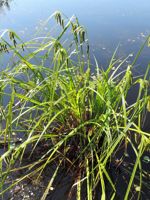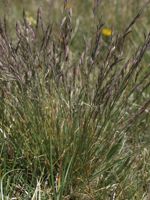Mon-Fri 9am - 5pm Mountain time
Cyperus-like Sedge vs Rocky Mountain Fescue
Carex pseudocyperus
Festuca saximontana
CUSTOM GROW
CUSTOM GROW
Cyperus-like Sedge is a native perennial sedge found in wetlands, marshes, swamps, and along shorelines. Classified as an obligate wetland species, it grows in dense clumps that thrive in saturated soils, helping stabilize wet ground and protect shorelines. These colonies also provide cover for wildlife, while the seeds may be eaten by waterfowl and other birds. It is well-suited to wetland restoration, waterside and riparian zone plantings, and naturalization projects.
Its ornamental appeal comes from the contrast between the upright male floral spikes at the top of the stems and the long, drooping female floral spikes that hang below. These seed spikes resemble those of Cyperus species, giving the plant its common name and making it an attractive addition to naturalized plantings.
Rocky Mountain Fescue is a native perennial bunchgrass recognized for its fine-textured clumps and adaptability to harsh environments. It grows well in dry, rocky, and nutrient-poor soils and is highly cold-tolerant, making it well-suited to both prairie and alpine habitats. Its fibrous root system contributes to soil stability and helps reduce erosion on slopes and shallow soils.
Widespread across western and northern North America, Rocky Mountain Fescue is an important component of many prairie and alpine ecosystems. It contributes ground cover and organic matter that support soil function, provides cover for small wildlife, and offers moderate forage for grazing animals. Hardy and versatile, it is used in ecological restoration, naturalization, and habitat enhancement projects, particularly in upland and alpine landscapes.

